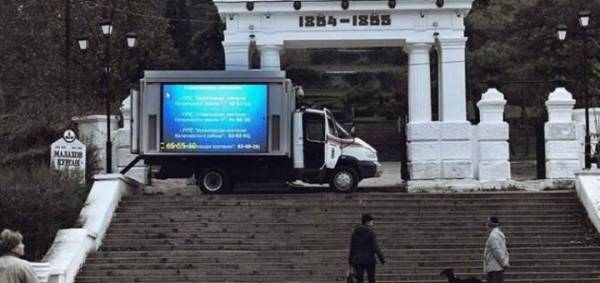
The Crimean Blockade: An Unfinished Saga
Publication: Eurasia Daily Monitor Volume: 12 Issue: 223
By:

Crimea, which had almost faded from the global political agenda following Russia’s ensuing military operations, first in Eastern Ukraine and then in Syria, has again reemerged in the headlines.
Despite the Russian occupation, the annexed peninsula continued to receive all its critical goods, services and power from mainland Ukraine, largely uninterrupted until this fall. But on September 20, Crimean Tatars, backed by Ukrainian activists (particularly, those from the Right Sector and other patriotic organizations, as well as volunteers), started blocking food supplies imported from Ukraine to Crimea across a narrow land bridge (see EDM, October 2). Then, four power line pylons supplying the occupied peninsula with electricity were blown up in Ukraine’s Kherson Region, close to the Crimean border, on November 22. Although the activists refused to accept responsibility for the damage, they initially prevented the towers from being repaired (Ukraine Today, November 27). Most recently, Lenur Islyamov, the Crimean Tatars’ actions coordinator, suggested that possible next steps in their campaign against Russia’s annexation of their homeland could include halting gas, water and maritime access to Crimea (Openrussia.org, November 30).
While activists said their ultimate goal was to return Crimea to Ukraine, their immediate demand was that Russia free several internationally recognized Ukrainian (pilot Nadiya Savchenko and filmmaker Oleg Sentsov) and Crimean Tatar (Mejlis member Akhtem Chiygoz) political prisoners as well as end political repression on the peninsula (Deutsche Welle—Russian service, September 21).
Crimea can cover just about 30 percent of its power needs on its own, while Ukraine had traditionally handled the rest. So since the beginning of the electricity blockade, Russia has intensified laying underwater electricity cables to the peninsula from Russia’s Krasnodar Territory (Northern Caucasus). On December 2, Russian President Vladimir Putin paid a special visit to the peninsula to inaugurate the “energy bridge” across the Kerch Strait (RIA Novosti, December 2). According to Putin, the project’s first phase will reach its full 200-megawatt capacity by early January 2016, and a second phase of identical capacity is scheduled to come online in December of next year. Putin pledged the bridge would be gradually upgraded to meet Crimea’s total demand of 1,100 megawatts (Kerch-most.ru, December 3).
However, after much fanfare, the energy bridge faced numerous “disruptions” virtually as soon as it was put into operation (Joinfo.ua, December 5). Electricity from Russia to Crimea flowed for only a few hours at a time and often became interrupted due to excessive demand, caused by increasingly harsh winter weather conditions. Heating works in only 60 percent of Crimea’s residential buildings.
According to energy expert Mykhailo Gonchar, the president of the Kyiv-based Strategy XXI Center, neither Crimea’s easternmost city of Kerch nor neighboring Krasnodar Territory, in the Russian Federation, have the infrastructure necessary to properly transmit power to the occupied peninsula. It could take months or years to build it. “The energy bridge might be a true utopia,” he said (Istochnik.info, July 21).
In the meantime, Russia has shipped more than 700 mobile generators to Crimea and declared it was ready to transport oil to the peninsula by sea. Notably, Russian authorities have also shipped mobile wide-screen television vans to darkened Crimea to maintain propaganda-rich television broadcasts from Moscow. “They are going to have electricity as expensive as gold,” Crimean Tatar Mejlis chairman Refat Chubarov commented (Segodnya.ua, December 1).
The Russian Communist Party’s proposal to use the Black Sea fleet’s submarines to supply power to Crimea lent a phantasmagoric color to the discussion (Flashcrimea.com, November 29). Still, the most absurd statement came from Vladimir Konstantinov, the chairman of the Kremlin-backed State Council of Crimea: “We have heard that many newborn girls [since the black-out] have been given the name of Sveta [Russian ‘svet’ means ‘light’]. So there has appeared an absolutely bright idea to give newborn boys the name of Generator,” he said at a State Council meeting (Flashcrimea.com, December 4).
“Even if Ukraine decides to resume power supply [to the peninsula], we shall not accept it at any price,” declared Konstantinov’s long-time associate and Crimea’s self-proclaimed head, Sergey Aksyonov, on December 7. He confirmed his and his “fellow-citizens’ determination to get rid of everything Ukrainian” (C-inform.info, December 7). Later that same day, however, one power line linking Ukraine’s Kherson Region and Crimea resumed operation. Crimean Tatars had decided to ease their protest in order allow the reconnection of two districts of Kherson to the power grid, after which the Right Sector entirely withdrew from the action. Aside from the two districts, the Kakhovka-Tytan overhead power line supplies electricity to the two Crimea-based chemical processing plants (Crimean Titan and Crimean Soda) controlled by the Ukrainian-Russian gas baron Dmitry Firtash.
Interestingly, earlier this month, Ukrainian member of parliament Igor Kononenko (Petro Poroshenko Bloc) had warned the Ukrainian people that the electricity blockade of Crimea could result in the halt of coal supplies from Russia and subsequent winter black-outs all over Ukraine (112.ua, December 5). That looming background threat motivated some observers to suggest the possibility of Kyiv and Moscow striking a backroom deal. Indeed, in the opinion of Russian historian Valeriy Solovey, a professor at the Moscow International Relations Institute, Kyiv agreed to resume electricity supplies to Crimea in exchange for resumed Russian coal shipments to Ukraine (Facebook.com, accessed December 11).
Having lasted for a little more than two weeks, the electricity blockade has thus now been suspended. According to their coordinator, Lenur Islyamov, the activists were being pressured by both Ukrainian and Western governments to prevent a “humanitarian catastrophe” in Crimea. Now, the issue will wait to be settled by January 1, 2016, when the Russo-Ukrainian contract on the power supply to the peninsula expires. “If the Ukrainian parliament does not prolong the agreement, we will continue the action,” he said. “We would like to be supported by the Ukrainian Rada deputies” (Interfax, December 8).
So on the one hand, the blockade organizers have failed to achieve their primary stated goals, as Russia has not released any of the political prisoners while repressions on the peninsula have not stopped. Still the very fact of the blockade has revitalized the Crimean question and raised it back up to the national and global level. And perhaps even more importantly, the action has demonstrated Crimea’s critical dependence on mainland Ukraine, which Russia has yet to be able to overcome.




